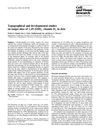TLDR Alopecia indicates more severe resistance to 1,25-dihydroxyvitamin D.
The study analyzed the relationship between alopecia and hereditary resistance to 1,25-dihydroxyvitamin D (1,25(OH)2D) in 30 kindreds. It found that alopecia was associated with more severe resistance, as indicated by an earlier age of diagnosis (0.9 years vs. 3.3 years) and a lower calcaemic response to calciferol therapy. During treatment, patients with alopecia had lower serum calcium levels but higher serum 1,25(OH)2D levels compared to those with normal hair. Additionally, cells from most kindreds with alopecia showed no response to 1,25(OH)2D3 in terms of 24-hydroxylase activity, unlike those from kindreds with normal hair. The findings suggested that alopecia in these cases reflected more severe resistance to 1,25(OH)2D.
55 citations
,
May 1985 in “Archives of Dermatology” 11 citations
,
May 1985 in “Archives of Dermatology”  70 citations
,
November 1984 in “Cell & tissue research/Cell and tissue research”
70 citations
,
November 1984 in “Cell & tissue research/Cell and tissue research” Vitamin D3 affects cell differentiation in specific skin areas.
110 citations
,
November 1984 in “The American Journal of Medicine” A genetic defect in vitamin D receptors causes severe rickets and hair loss in children, but some heal as they age.
88 citations
,
October 1983 in “The Journal of clinical endocrinology and metabolism/Journal of clinical endocrinology & metabolism” Patients with this syndrome can have different responses and worsening resistance to treatment over time.
 82 citations
,
April 1981 in “Clinical endocrinology”
82 citations
,
April 1981 in “Clinical endocrinology” A girl with rickets and hair loss was found to have a rare condition where her body didn't respond to vitamin D treatment.
82 citations
,
October 1980 in “The Journal of Clinical Endocrinology & Metabolism” The child's body didn't respond well to vitamin D, causing hair loss and rickets.
170 citations
,
May 1979 in “The journal of pediatrics/The Journal of pediatrics” Two sisters with rickets and hair loss had a genetic issue with vitamin D processing, and only improved when given phosphorus supplements.

